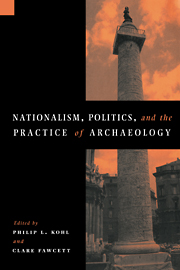Book contents
- Frontmatter
- Contents
- List of maps
- List of contributors
- Acknowledgments
- Part I Introduction
- Part II Western Europe
- Part III Eastern Europe and Eurasia
- Part IV East Asia
- 11 Thirty years of Chinese archaeology (1949–1979)
- 12 The regionalist paradigm in Chinese archaeology
- 13 The politics of ethnicity in prehistoric Korea
- 14 Nationalism and postwar Japanese archaeology
- Part V Commentary
- Bibliography
- Index
14 - Nationalism and postwar Japanese archaeology
Published online by Cambridge University Press: 06 October 2009
- Frontmatter
- Contents
- List of maps
- List of contributors
- Acknowledgments
- Part I Introduction
- Part II Western Europe
- Part III Eastern Europe and Eurasia
- Part IV East Asia
- 11 Thirty years of Chinese archaeology (1949–1979)
- 12 The regionalist paradigm in Chinese archaeology
- 13 The politics of ethnicity in prehistoric Korea
- 14 Nationalism and postwar Japanese archaeology
- Part V Commentary
- Bibliography
- Index
Summary
In August 1945 the Japanese people, crushed by years of war and numbed by the final horrors of Hiroshima and Nagasaki, awaited the arrival of the Allied Forces. Within a few months the work of rebuilding postwar Japan would begin. Part of this process involved the creation of a new vision of the Japanese people's national identity, a new image of what it meant to be Japanese.
In this paper I will trace the relationship between postwar Japanese archaeology and this new sense of Japanese national identity. I will argue that in the aftermath of World War II, Japanese archaeologists believed that their discipline could prevent a revival of emperor worship and extreme nationalism by using material remains to rewrite ancient Japanese history. This approach, which focussed on the retrieval and description of primary data, was highly empirical. In the 1950s and 1960s, a goal of archaeological work was to collect and organize materials excavated through academic research projects. Later, during the 1970s and 1980s, information began to come mainly from administrative rescue excavations. Archaeologists found themselves unable to keep up with the constant need both to excavate sites threatened with destruction and to publish the results in a form accessible to the general public. Consequently, archaeological information has gradually been incorporated into a broader discourse, one which revolves around the definition of a new Japanese national identity.
- Type
- Chapter
- Information
- Nationalism, Politics and the Practice of Archaeology , pp. 232 - 246Publisher: Cambridge University PressPrint publication year: 1996
- 8
- Cited by



